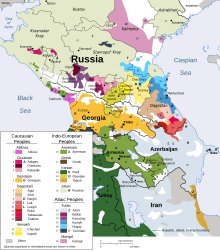
Back Ауаԥс бызшәа Abkhazian Osseties Afrikaans ኢሮንኛ Amharic Idioma oseta AN ओस्सेटियन भाषा ANP اللغة الأوسيتية Arabic الاوسيتيه ARZ Idioma osetiu AST Осетин мацӀ AV Osetin dili Azerbaijani
This article should specify the language of its non-English content, using {{lang}}, {{transliteration}} for transliterated languages, and {{IPA}} for phonetic transcriptions, with an appropriate ISO 639 code. Wikipedia's multilingual support templates may also be used - notably oss for Ossetian. (October 2021) |
| Ossetian | |
|---|---|
| ирон ӕвзаг (iron ævzag) дигорон ӕвзаг (digoron ævzag) | |
 Latin-script Ossetian text from a book published in 1935; part of an alphabetic list of proverbs. | |
| Pronunciation | [iˈron ɐvˈzäɡ] [digoˈron ɐvˈzäɡ] |
| Native to | Ossetia |
| Region | Caucasus |
| Ethnicity | 700,000 Ossetians |
Native speakers | 490,000 (2020 census)[1] |
Standard forms |
|
| Dialects | |
| Official status | |
Official language in | Russia |
| Language codes | |
| ISO 639-1 | os |
| ISO 639-2 | oss |
| ISO 639-3 | oss |
| Glottolog | osse1243 |
| Linguasphere | 58-ABB-a |
 Ossetian is classified as Vulnerable by the UNESCO Atlas of the World's Languages in Danger[2] | |

Ossetian (/ɒˈsɛtiən/ o-SET-ee-ən, /ɒˈsiːʃən/ o-SEE-shən, /oʊˈsiːʃən/ oh-SEE-shən),[3][4] commonly referred to as Ossetic and rarely as Ossete[5] is an Eastern Iranian language that is spoken predominantly in Ossetia, a region situated on both sides of the Russian-Georgian border in the Greater Caucasus region. It is the native language of the Ossetian people, and a relative and possibly a descendant of the extinct Scythian, Sarmatian, and Alanic languages.[6]
The northern half of the Ossetian region is part of Russia and is known as North Ossetia–Alania, while the southern half is part of the de facto country of South Ossetia (recognized by the United Nations as Russian-occupied territory that is de jure part of Georgia). Ossetian-speakers number about 614,350, with 451,000 recorded in Russia per the 2010 Russian census.[7]
Despite Ossetian being the official languages of both North and South Ossetia, since 2009 UNESCO has listed Ossetian as "vulnerable". In the 2010 Russian census only 36% of North Ossetians claimed to be fluent in Ossetian, with the number decreasing year by year.[8]
- ^ Ossetian at Ethnologue (26th ed., 2023)

- ^ "World Atlas of Languages: Ossetian". www.unesco.org. Archived from the original on August 2, 2018. Retrieved Mar 3, 2021.
- ^ AHD:Ossetian
- ^ OED:Ossetian.
- ^ Dalby 1998.
- ^ Lubotsky, Alexander (2010). Van Sanskriet tot Spijkerschrift Breinbrekers uit alle talen. Amsterdam: Amsterdam University Press. p. 34. ISBN 978-9089641793.
- ^ "Ossetic". Ethnologue. Retrieved 2019-01-08.
- ^ Fuller, Liz (28 May 2015). "One Nation, Two Polities, Two Endangered Ossetian Languages?". Radio Free Europe/Radio Liberty. Retrieved 23 February 2024.